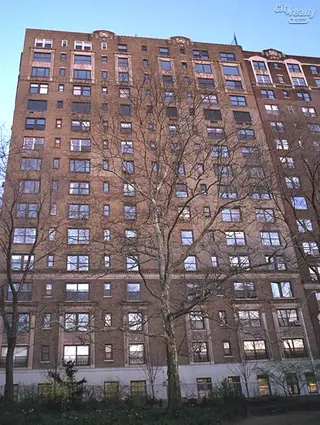 Carter Horsley
Carter HorsleyDec 23, 2011
Carter's Review
Erected in 1926 and converted to a cooperative in 1970, this attractive, 15-story building at 285 Riverside Drive on the southeast corner at 101st Street has 86apartments.
It was designed by Rosario Candela for Charles Paterno, the team also responsible for the very similar buildling at 280 Riverside Drive.
Bottom Line
Although not one of his most famous buildings, this is a Rosario Candela-designed building erected for one of the famous Paterno Brothers at a prime Riverside Drive location near the handsome Firemen’s Memorial.
Description
Sometimes, an architect will try to be innovative with a variation on a style, or traditional element, in an attempt to raise eyebrows.
Here, it is the building itself that has slightly raised eyebrows
It has a distinctive roofline with two low, curved arches in the middle of its Riverside Drive façade.
The 90's along Riverside Drive is quite interesting and 243 Riverside Drive at 96th Street also has a roof line with some curves, but they are part of a more consistent and interesting design.
The design here is rather subtle. Subtlety, of course, is always to be encouraged and this building's roofline is not bad at all even if the "eyebrows" are rather minimal. Curves are very welcome in such a rectilinear city as New York and Riverside Drive's sinuous curves are well suited to experimentation.
The beige-brick building has a sidestreet entrance with nice wrought-iron doors leading to a step-up lobby. It has a one-story limestone base, no canopy, inconsistent fenestration, attractive terracotta pilasters and spandrels on the second and third floors and protruding air-conditioners.
This building has a one-story limestone base and two-story-high window surrounds on the second and third floors and the top two floors.
It has two triangular decorative elements on its façades on Riverside Drive and the side-street.
It has some protruding air-conditioners and no sidewalk landscaping.
It has a one-step-up entrance on the side-street.
Amenities
The building has a doorman.
Apartments
Apartment 15A is a three-bedroom unit with an 11-foot-long entrance gallery that leads to a 25-foot-long living room, a 15-foot-long, windowed dining room, a 9-foot-long maid’s room and a 13-foot-long kitchen.
Apartment 12G is a three-bedroom unit with a 9-foot-long entry foyer that opens onto a 23-foot-long living room that opens onto a 14-foot-square den and a 13-foot-long dining room next to a 19-foot-long, windowed kitchen.
Apartment 12D is a two-bedroom unit that has a 10-foot-long entry foyer that leads to a 24-foot-long living room in one direction and a 19-foot-long, windowed dining room next to a 7-foot-long breakfast room and a 13-foot-long, windowed kitchen in the other.
Apartment 2F is a two-bedroom unit with a long entry foyer that leads to a large living room next to a large kitchen.
Apartment 5C is a two-bedroom unit that has a 31-foot-long entrance gallery that leads to a 24-foot-long living room that opens onto a 13-foot-wide dining room next to a 9-foot-oong butler’s pantry, an 18-foot-long kitchen and a 13foot-long staff room. The apartment also has a 13-foot-long windowed home office.
History
A September 10, 2000 “Streetscapes” column in The New York Times by Christopher Gray noted that a small triangular park had been finished at Castle Village on Cabrini Avenue north of 181st Street in Upper Manhattan commemorating Charles Paterno, the developer.
The developer’s father, John, left Castelmezzano, Italy in the 1880s with his wife, Carolina, after an earthquake destroyed one of his building projects. One of his sons Saverio, stayed in Italy, but Charles and Joseph came to the United States and the couple had more children, Michael and Anthony.
Eventually the brothers joined the firm that became known as the Paterno Brothers Construction Company.
In 1909, Charles Paterno building the “Paterno Castle,” which stood to the north of Castle Village. “Period descriptions said it included rooms of various styles – including one in a Japanse motif – a mushroom motif, a swimming pool surrounded by bird cages and a 20-by-80-foot master bedroom,” according to Mr. Gray’s article, which added that Paterno expanded the site to seven acres. In 1910, he continued, Charles built with Joseph, 435 and 440 Riverside Drive at 116th Street and Joseph would later build 1220 Park Avenue, Michel would building 775 Park Avenue and Anthony built one at 1040 Fifth Avenue.
Charles Paterno, Mr. Gray continued, would building 300, 575 and 885 West End Avenue and 280, 285 and 290 Riverside Drive and in 1918 the full-block 270 Park Avenue and in 1924 he erected Hudson View Gardens across from his estate, on the block between Northern (now Cabrini) Boulevard and Pinehurst Avenue and a few years later he announced “a plan for a 90 story apartment house across the Hudson on the Palisades, but the plan was never carried out.”

- Co-op built in 1926
- Located in Riverside Dr./West End Ave.
- 86 total apartments 86 total apartments
- 10 recent sales ($370K to $2M)
- Doorman
 6sqft delivers the latest on real estate, architecture, and design, straight from New York City.
6sqft delivers the latest on real estate, architecture, and design, straight from New York City.
